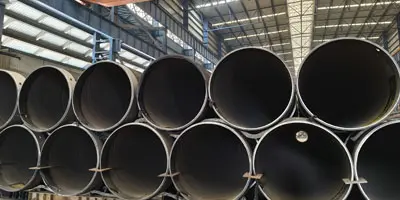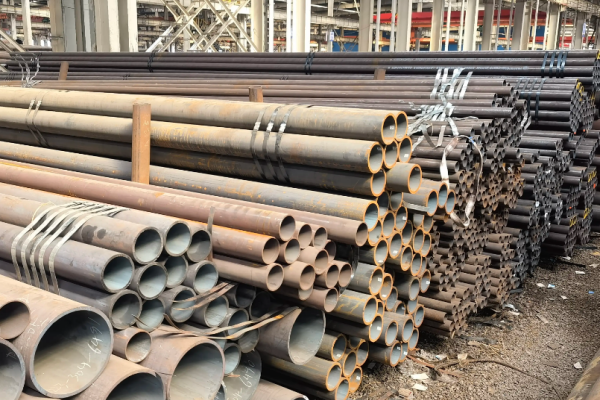What is low carbon steel pipe?
As the name implies, low carbon steel pipe is a steel pipe with a low carbon content. Generally speaking, there is a difference between low carbon steel pipe and
seamless carbon steel pipe. Low carbon steel pipe refers to a steel pipe with a carbon content of less than 0.3%, and seamless low carbon steel pipe is one of them. Low carbon steel pipes include general steel pipes, medium and low pressure boiler steel pipes, high pressure boiler steel pipes, alloy steel pipes, stainless steel pipes, petroleum cracking pipes and other steel pipes, as well as carbon thin-walled steel pipes, alloy thin-walled steel pipes, stainless steel thin-walled steel pipes, special-shaped steel pipes, etc.
Low carbon steel is also called soft steel because of its low strength, low hardness and soft texture. It includes most ordinary carbon structural steels and some high-quality carbon structural steels. Most of them are used for engineering structural parts without heat treatment, and some are used for mechanical parts requiring wear resistance after heat treatment such as carburizing. Low carbon steel with carbon content of 0.10% to 0.30% is easy to forge, weld and cut, and is commonly used in chains, rivets, bolts, shafts, etc.
Cold drawn and hot rolled bars are both low carbon steel. Hard steel and low carbon steel are divided based on whether they have a yield point or not, because hard steel has no obvious yield point and plasticity compared to low carbon steel, and its control stress factor is lower than that of low carbon steel.
Characteristics of Low Carbon Steel Pipe
Some of the notable features of low carbon steel pipes and steel pipes are high tensile strength, these pipes meet the American Society for Testing and Materials (ASTM) specifications, MS pipes are very strong, low carbon content, can be easily welded, simple to manufacture, easy to use, not very expensive compared to other metals, and exist for 100 years or more. Some of the major applications of low carbon steel pipes are structural purposes, mechanical reasons, general construction, residential applications, planned transportation bodies, fences, building structures, and water supply steel pipes.
How is low carbon steel manufactured?
The manufacturing process of low carbon steel is similar to that of other carbon steels. These processes have been changing over time and are currently more efficient and cheaper than before. In modern manufacturing processes, there are three main steps involved in producing low carbon steel from pure iron or iron ore.
1. Primary steelmaking
In this process, iron is mixed with coal and lime and heated in a blast furnace. Modern primary steelmaking uses modern furnaces such as basic oxygen furnaces or electric arc furnaces. Generally, the steel parts coming out of electric arc furnaces are of high quality.
2. Secondary steelmaking
The purpose of secondary steelmaking is mainly to reduce the carbon content to the required level and add other alloying elements to improve the properties of the steel. This step is mainly to control and monitor the heat treatment and cooling of the furnace.
3. Casting and primary forming
As soon as the steel in the furnace reaches the specified carbon content and the mechanical properties are improved to a certain level, the steel is poured into a mold. This is called casting. Some people also say cast iron, which is wrong. During this process, the liquid steel will solidify and form various geometric shapes. These crystal structure cast steels will then be cut into smaller parts.
Cast steel has many defects. A primary forming process called hot rolling is used. After hot rolling, steel acquires more strength, ductility, weldability, etc.
Applications of Mild Steel Pipes
Some of the notable features of mild steel pipes and tubes are high tensile strength, these pipes meet the American Society for Testing and Materials (
ASTM) specifications, mild steel pipes are very strong, low carbon content, can be easily welded, simple to manufacture, easy to work with, not very expensive compared to other metals, and exist for 100 years or more. Some of the major applications of mild steel pipes are structural purposes, mechanical reasons, general construction, residential applications, planning transport bodies, fencing, building structures, and water supply steel pipes.
Square mild steel pipes have notable features such as high quality, large consumption barriers, high strength, and easy deformation. Round mild steel pipes are used in some applications, such as modern water pipelines, plant access, agribusiness and water supply systems, incentive steel fences, street barriers, stop boundaries, fences, steel doors and windows, roadside railings, foundation and construction works, water supply pipelines, etc.
No. 20 steel
The 20 in No. 20 steel refers to the carbon content of 0.2%, which is low carbon steel. Steel can be divided into low carbon steel, medium carbon steel and high carbon steel.
Carbon content: low carbon steel is generally less than 0.25%; medium carbon steel is generally between 0.25% and 0.60%; high carbon steel is generally greater than 0.60%.
In addition to carbon (C) elements and a certain amount of silicon (Si) (generally not more than 0.40%) and manganese (Mn) (generally not more than 0.80%, up to 1.20%) and other alloying elements used for deoxidation, steel does not contain other alloying elements (except residual elements).
Usually, wrought iron with a carbon content of less than 0.02% is called wrought iron, pig iron with a carbon content of more than 2.11% to 4.3% is called pig iron, and steel is between the two.
What is Mild Steel?
The main component of steel is iron. According to the different carbon content, there are low carbon steel (also called low carbon steel or ordinary carbon steel), medium carbon steel and high carbon steel.
The figure below shows the differences and characteristics of these three types of steel.
|
name
|
Carbon content (wt. %)
|
Microstructure
|
feature
|
|
Mild Steel (Low Carbon Steel)
|
Less than 0.25
|
Pearlite, Ferrite
|
Soft, cheap, ductile, easy to process and weld
|
|
Medium Carbon Steel
|
0.25 to 0.60
|
Martensite
|
Moderate ductility, hardness, strength and resistance to hardening
|
|
High carbon steel (carbon tool steel)
|
0.60 to 1.25
|
Pearlite
|
Very hard, strong, unyielding, difficult to machine and weld
|
From the above picture, we can see that mild steel is a type of steel containing 0.05%-0.25% carbon. Due to its plasticity and ductility, the material is easy to form and process. Mild steel parts are generally very suitable for stamping and forging. Mild steel is widely used in tools, automotive body parts, construction and infrastructure.
Summary
Low carbon steel has a carbon content of less than 0.25. Due to its properties, low carbon steel is widely used in almost all industries. The common method of making prototype or small batch production-level parts of low carbon steel is through CNC machining. For high-volume products, metal injection molding and casting are more feasible methods.
As a professional prototype and mass production service provider,
Baowi steel has many years of experience and expertise in machining different types of carbon steel, stainless steel, alloys, etc. If you have a project related to low carbon steel machining, please get a quote.






 English
English Español
Español بالعربية
بالعربية











 Phone :
Phone :  Whatsapp :
Whatsapp :  Email :
Email : 


